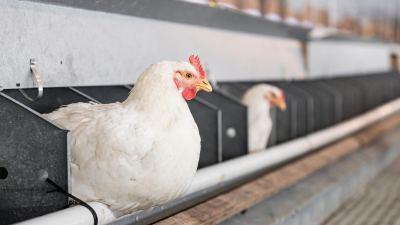Don't let Salmonella come home to roost

The risk for Salmonella can be reduced on the poultry farm by addressing the main sources of bad bacteria.
According to the Centers for Disease Control and Prevention, every year in the United States, Salmonella is estimated to cause 1 million foodborne illnesses, with 19,000 hospitalizations and over 300 deaths. The most common symptoms of a Salmonella infection are diarrhea, fever and abdominal cramps. Although illness from Salmonella can be the result of multiple factors, including improper food preparation, poultry producers can help reduce the risk to consumers through good farm practices.
Potential sources of bacterial contamination:
- Wild birds/pests (e.g., beetles, flies, rodents)
- Water
- Visitors
- Human personnel’s hygiene
In poultry production, there are eight areas that require attention in order to reduce bad bacterial contamination on-farm and aid in the prevention of Salmonella.
1. Cleaning and hygiene
Residual contamination from previous flocks is a common reason for Salmonella-positive birds. Cleaning growing houses between flocks can significantly reduce the prevalence of Salmonella in live production. Effective biosecurity and pest control are also key to avoiding contamination.
2. Feed
Contaminated grains and feed ingredients can increase the risk of Salmonella in the final feed. Use heat-pelleted feed and source feed from mills operating with stringent quality standards.
3. Water management
Water management is a crucial part of any Salmonella control program in poultry, since water can serve as a medium for the organism to spread from bird to bird. Chlorinated water and the use of organic acids in the water have been shown to reduce Salmonella levels in the flock.
4. Dust
Dust can also be a medium for Salmonella to spread. A system that keeps dust levels below 3 milligrams per cubic meter is an important prevention tool.
5. Litter management
Poultry litter with high moisture and pH levels allows Salmonella to thrive. Managing the moisture and pH of the litter has been shown to be an effective way to control Salmonella in live poultry production.
6. Managing gut flora
Establishing and maintaining proper gut flora soon after hatching is very important to prevent Salmonella from colonizing birds. Programs that include the use of probiotics, organic acids, enzymes and yeast technologies have been shown to be effective at maintaining optimal gut health.
7. Coccidiosis
Intestinal challenges caused by poor gastrointestinal integrity can have a big impact on Salmonella levels in broilers. Strong cocci management needs to be part of every Salmonella control program.
8. Vaccination
The use of vaccines, especially at the breeder level, has the potential to reduce the prevalence of Salmonella among day-old chicks.
If you would like to learn more about how you can stop the spread of Salmonella in your poultry operation, please fill out the form below.















